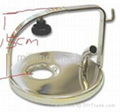| Model: | LL80 |
|---|---|
| Brand: | CSJ |
| Origin: | Made In China |
| Category: | Agriculture & Foods / Agricultural Products & Resources / Animal Husbandry |
| Label: | pneumatic pulsator , cow milk pulsator , goat pulsator |
| Price: |
US $18
/ pc
|
| Min. Order: | 50 pc |
| Last Online:07 Dec, 2020 |
Vacuum Milk Pulsator L80 For Cow,Goat & Sheep
1.L80 Pulsator
2.Pulsation Rate: 60/40 Adjustable
3.proved by ISO9001 & CE
4.Competetive price
5. Feature:It is manufactured in long lasting materials and functions without electricity.
6.Net weight: 430g
7.Copy of interpulse
What is Pulsation?
All milking systems are set up to keep the milking claw under constant vacuum to draw milk from the udder. If the teats were subjected to this continuous vacuum, blood would not re-circulate and would pool at the teat end causing it to swell shut, trapping the milk in the udder. Pulsation recreates the normal milking action of a suckling calf by periodically interrupting the claw's constant vacuum. It achieves vacuum interruption by admitting atmospheric air (i.e. air at higher pressure than the milking system's vacuum) between the shell and inflation, which collapses the inflation and seals the teat off from vacuum. During this "rest" phase the blood that has been pulled to the end of the teat by the vacuum re-circulates preparing the teat for another "milk phase."
Optimum pulsation depends on stable vacuum at the teat end, the appropriate inflation and a good pulsation system. If these three are correct the pulsator should fulfill several beneficial functions. It should collapse the liner completely without slapping and open the inflation completely without ballooning. It should shift between the milk phase and rest phase quickly, smoothly and, above all, consistently (constant exact repetition of the pulsation action trains the cow for fast milk letdown and maximizes production). Erratic pulsation makes the cow uncomfortable, which delays milk out, lengthens milking times, and does not promote good udder health.
Rates and Ratios
The rate of the pulsation system is the number of times the inflation opens and closes per minute, which is referred to as pulsations per minute (PPM). Parts Dept.'s pulsators cover a wide range of rates between 45PPM to 75PPM. The pulsation ratio is defined as the percentage of time the inflation is in the milking phase or the rest phase. The first number represents the milking phase, the second is the rest phase. For example, in a 60:40 ratio - during 60% of one pulsation the inflation is in the milk phase and 40% of one pulsation is in the rest phase. The rate and ratio are set independently of each other, but together play an important role in your milking system. Parts Dept.'s electric and pneumatic pulsators offer a variety of rates and ratios. Please see the specifications for each of the individual pulsators and controllers.
Listed below is the amount of time the teats get to rest at various ratio settings:
Rate Ratio Number of Seconds
Rest per Minute
70 PPM 70:30 18 Seconds/minute
60 PPM 60:40 24 Seconds/minute
50 PPM 50:50 30 Seconds/minute
Independently Set Front and Rear Rates and Ratios
Synchronized Front and Rear Quarter Milking
A cow's rear quarters give more milk than its front quarters. This fact caused a dilemma with traditional pulsation which milked front and rear quarters at the same ratio and rate. If both the front and rear are milked at the same rate and ratio either the front teats are being over milked or the rear teats are being under milked. To counteract the different milk yield of front and rear quarters, electric pulsation controllers were developed that allowed different rate and ratio settings for the front and rear quarters so that the entire udder could be fully milked out simultaneously. For example, these controllers allow the front teats to be milked at a ratio of 55:45 and a rate of 50 PPM and the rear teats at 60:40 and 55 PPM, or a variety of other front and rear rates and ratios.
Independently set front and rear ratios improve milk out, maximize production and promote udder health. Marked improvement will be seen especially with cows that have had their rear quarters habitually under milked to coincide with the front quarters' milk out. The higher independent rear setting will train cows to yield more from the rear teats as they do naturally. Because their rear teats generally give about 10% more milk than the front teats, it is recommended that the difference in ratio between front and rear not exceed 10%, i.e. if the front setting is 50:50 the rear setting should be 55:45. If the front is 55:45, the rear should be 60:40 and so on.
Setting Rates and Ratios Milking Speed versus Udder Health
"The 60:40 Compromise"










